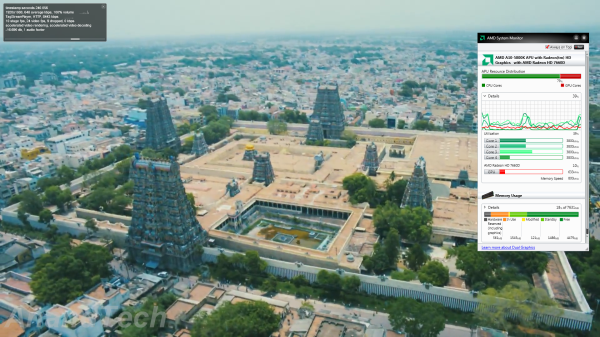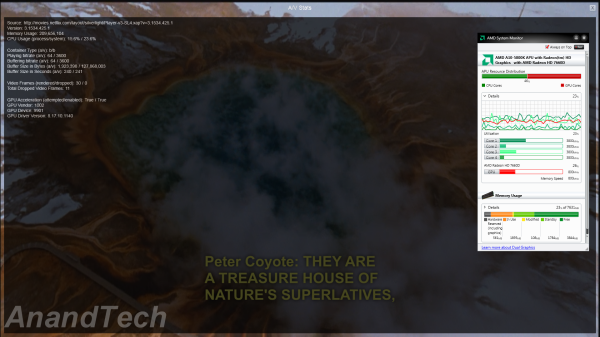AMD's Trinity : An HTPC Perspective
by Ganesh T S on September 27, 2012 11:00 AM ESTFlash acceleration has traditionally worked without issues in AMD and NVIDIA drivers, unlike Intel. Intel and Adobe got it right with Ivy Bridge. Fortunately, things look good with Trinity too. As the screenshot below indicates, we have full GPU acceleration for both decoding and rendering. AMD's System Monitor shows how the CPU and GPU resources are balanced when playing H.264 Flash videos.
Netflix streaming, on the other hand, uses Microsoft's Silverlight technology. Unlike Flash, hardware acceleration for the video decode process is not controlled by the user. It is up to the server side code to attempt GPU acceleration. Thankfully, Netflix does try to take advantage of the GPU's capabilities.
This is evident from the A/V stats recorded while streaming a Netflix HD video at the maximum possible bitrate of 3.7 Mbps. The high GPU usage in the AMD System Monitor also points to hardware acceleration being utilized.
One point which deserves mention here is that Flash and Silverlight acceleration works without hiccups here, unlike what we saw in the Brazos-based machines (where the CPU was too weak despite the availability of hardware acceleration through the GPU).












49 Comments
View All Comments
Denithor - Tuesday, October 2, 2012 - link
Which explains 1600p on 30" monitors, right?Granted, most of us don't sit 3-4' from our TV but I know even on my 50" 1080p barely cuts it (text is hard to read sometimes, fuzzy if I zoom in enough to read easily).
OCedHrt - Thursday, September 27, 2012 - link
Meaning, setting it to 16-235 means to discard 0-15 and 236-255 and expand the remainder to full RGB.Obviously I don't have a Trinity setup so I'm just speculating, but on my HD6400 there is a different parameter on the display configuration section to tweak screen output range - which I set to RGB full range.
ganeshts - Thursday, September 27, 2012 - link
I think you are referring to the pixel format output which is YCbCr 4:4:4 / YCbCr 4:2:2 / RGB Limited / RGB FullThe dynamic range aspect is orthogonal to the pixel format output over HDMI.
The screenshot posted is that of a video playing in the background. Sorry if that wasn't clear. I am not sure about AMD's terminology here, but any user setting the dynamic range to 16-235 would expect NOT to see values 0 - 15 and 236 - 255.
OCedHrt - Friday, September 28, 2012 - link
Yes I was referring to pixel format output. I use RGB Full. I was under the impression that YCbCr cannot display the ranges 0-15 and 236-255 but I think I might be wrong on this one. It is YV12 / YUY2 colorspaces that lack these ranges.And what you're saying about dynamic range is exactly what I'm saying is happening. If you select 16-235, 0-15 and 236-255 from the video is filtered out and the remaining is expanded back to 0-255. Thus a video decoded to YV12 / YUY2 space played on a full range display would have a greyish black or white without selecing 16-235 range. Meaning, the wording on AMD's UI is correct, just the whole idea behind it is confusing.
superccs - Friday, September 28, 2012 - link
Have all of our expectations of their new hardware dropped considerably? I am an AMD fan as much as the rest of you, but it just seems like we are trying so hard to find their stuff useful.CeriseCogburn - Saturday, October 13, 2012 - link
Good deal, another fanboy zombied out for years by the marketing hatred and hype useful idiots collective has shown a glimmer of light, hope that the slave mind can break free from the dirty chains.The new test is this: Would you put up with this crap from any other company or vendor ?
Hardcore69 - Friday, September 28, 2012 - link
- HTPC box: No point. A G540 + GTX 650 if you really want MadVR and 23.976.- Office box: No point. A G540 is enough for a basic everyday system
- Gaming box: No point. A dedicated card is still the answer for 1080p High/Ultra gaming i.e. real PC gaming.
Well? APU's are rather pointless. All this accelerated media crap, HD 1000 can do that too.
Medallish - Friday, September 28, 2012 - link
- HTPC Box: that's passively cooled: An A10-5700 would work great in there and be a nice upgrade!- Office/Workstation Box: GPU acceleration can make a lot of difference, not to mention people have different needs.
- Gaming Box: For someone who wants to game but don't want to shell out the money needed to get 1080p Ultra graphics, or as I see it, a gaming starter kit.
Well? APU's have plenty of point if you're not an out of touch Intel fanatic. Also did you even read the review? There was encoding and decoding that the APU did really well.
btw. I have a passively cooled HTPC, and a Laptop I use for office work, both based on APU's(Currently Llano, the HTPC is getting a Trinity upgrade though.) and I wouldn't want them any other way.
ssj3gohan - Monday, October 1, 2012 - link
Passively cooling a 130W box? Really?I'd like to see AMD trying a bit harder to keep their power consumption down, because in the end the reason for me to choose an i5-3570K was that like AMD it offered 'enough' GPU power, but at a much lower max power. My computer runs at well under 10W idle and about 75W max (OCCT+Furmark), more like 45W in normal use. I wouldn't be able to get near that kind of power consumption with equally-featured Trinity parts (aside from the lower CPU performance, which isn't really a big deal tbh).
(by the way, my 5.9W core i5-computer: http://ssj3gohan.tweakblogs.net/blog/8217/fluffy2-...
Medallish - Friday, October 5, 2012 - link
Yup, I've been working on my own little HTPC project(Although not as cool as yours :D). The Streacom FC5-OD is surprisingly good at cooling down even a 100W APU, right now I'm using a 3870k, I'm planning on getting the A10-5700 asap, and the final touch I plan on adding is the 6670, connect it to the opposite cooling ribs, however right now I'm running into a PSU limit, that I plan on countering by getting a slightly better PSU(250W CarPC PSU instead of a 150W picoPSU)But yeah despite the slightly higher load, the fact is on idle, and most likely average, AMD have really brought down power consumption with Trinity. But I like your setup, and will probably borrow a few ideas from there.